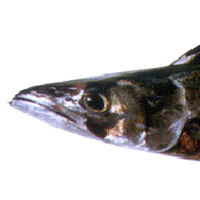Dark blue-grey back with silver sides and a belly tinged with blue or purple iridescence. Barracouta have a long slender form, a pointed head, and a large mouth with very sharp teeth that can cause severe cuts. They have smooth skin.
Barracouta are members of the Gempylidae family (snake mackerels). They are widespread in the southern oceans. In New Zealand, they are abundant around Cook Strait and further south. They are also not uncommon in more northern locations. They have a wide depth range, from close inshore to depths of 200 metres on the edge of the shelf. Barracouta are a school fish. They hunt mainly other small fish and also feed on mid-water plankton.
Barracouta tend to be migratory, particularly during spawning from late winter to late spring. Juveniles, which grow rapidly, congregate in sheltered waters such as the Hauraki Gulf, Tasman Bay, and the Canterbury Bight.
Once an undesirable by-catch, Barracouta are now an important resource for trawl fishermen. They are caught year-round in coastal waters around New Zealand, mainly off the South Island, and also around the Snares, and the Chatham Islands.


